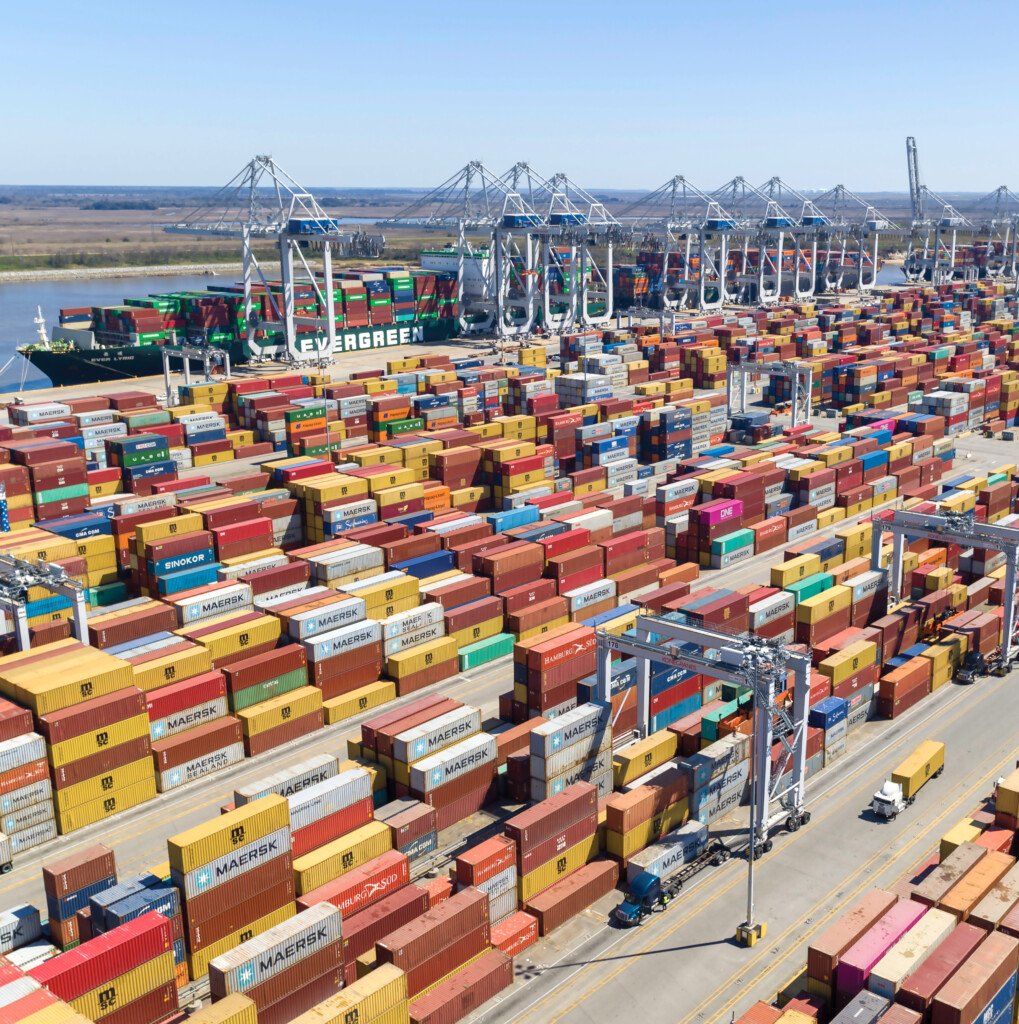From Georgia to the World
Port of Savannah argriculture exports continue to grow, benefitting Georgia economy and trading partners worldwide.
Georgia’s top agricultural export commodities, including forest products, poultry, pecans, peanuts and cotton, together with the Port of Savannah’s proximity to major producers, direct access via road and rail, broad global network and responsiveness to customer needs, made it the busiest port on the U.S. East Coast for the export of containerized agricultural goods last year.
“Our agriculture industry’s success depends in large part on our farmers’ ability to bring their goods to market, and Georgia’s ports are an incredible asset that have allowed our No. 1 industry to thrive,” says Georgia Agriculture Commissioner Tyler Harper. “From poultry to pulp wood, the Port of Savannah is the country’s leading exporter of agricultural goods, allowing our farmers access to sell their Georgia-grown products worldwide, putting our producers on the global map and creating more jobs right here in the No. 1 state for business.”
From breaking into new markets to improving logistics, work behind the scenes continues to pay off for Georgia growers and exporters, creating more demand for the state’s top ag products.
Growth at the Savannah port has been exponential, with a long list of record months in the books since August 2020, says former Georgia Ports Authority (GPA) Chair Joel Wooten, Jr. whose term ended last month. At the onset of the pandemic shutdown in March 2020, export volume dipped, but that was short-lived. Several months later, GPA reported its busiest August on record, and for a series of about 19 months or so, every month was the busiest ever for that month, he says.
“Things dropped off briefly, but then 2021 and 2022 were gangbusters,” he says.
Griff Lynch, GPA executive director, notes, “Historically, when you look back at the Georgia ports, [the volume of exports overall are what] allowed us to be who we are, and ag has always driven that.”
Of those ag exports, forest products make up the largest component, says Cliff Pyron, GPA’s chief commercial officer. “We have all the big paper mills, from International Paper to Georgia Pacific, and many other forest-products clients, so it’s always been big for us;
“And with Georgia being kind of the epicenter of poultry production in the United States, it’s always been a key export commodity for the Georgia ports, and it’s only going to grow,” he says, adding that Georgia ports are also No. 1 in the U.S. for cotton and peanut exports.
While most ag exports leaving Georgia ports are Georgia-grown, some products, such as grains and soybeans, come out of the Midwest. Tennessee and Arkansas contribute cotton, though on a much lower volume than Georgia, he adds.
To Market, To Market

International Trade: Gopi Munisamy, professor and head of the Agriculture and Applied Economics department, University of Georgia; photo Kevin Garrett.
As deputy commissioner for international trade with the Georgia Department of Economic Development, Mary Waters interacts with Georgia companies across all industries, including agriculture and food and beverage, working with growers, producers and farmers to get Georgia-made agricultural products out to global markets.
“My team works directly with the companies, understanding their market needs, understanding where they might want to go, what markets they might want to break into overseas, working in close partnership with the Georgia Department of Agriculture and their international team and providing market research and market intelligence, so our producers and growers are making data- driven decisions about their export markets,” says Waters.
The next step is getting them connected directly with qualified customers in those markets so they can achieve the greatest level of success in international markets. “Our approach, in terms of service delivery and providing export services to companies in Georgia, is the same for agricultural companies as it is for exporters in other industries.”
As of 2022, the current top ag export in Georgia is forest products. It’s no wonder as, according to the Georgia Forestry Association, the state leads the nation in privately owned timberlands, with more than 22 million acres of commercially available timber.
Fifty percent of forest exports go to Canada, Mexico and China, according to Gopi Munisamy, professor and head of the Agricultural and Applied Economics department at the University of Georgia. Exported forest products include wood pulp, paper, logs, boards and wood pellets. The pellets, made of compressed pine byproducts such as wood chips and sawdust, go primarily to Europe, followed by Japan, says Waters. In fact, Georgia is one of the top exporters of wood pellets to the world, according to the Georgia Forestry Commission.
“They’re used for energy, for heating. So instead of coal, instead of natural gas, the European market does still use wood pellets and wood-fired power generation for homes,” Waters says. “That’s a sustained market for Georgia. We’ve had good inroads with European buyers for quite some time for our wood pellets.”
Waters says pine logs make up the next largest forestry export, followed by rough, uncut pine lumber. The market for logs and rough-cut lumber is fairly diversified, she says, with the Netherlands, the United Kingdom and China topping the list, followed by Vietnam, India, the Philippines, Belgium and the French West Indies, among others.
“Georgia’s port infrastructure is a vital asset to the state and to the continued strength of the forest industry in the region. Forest products’ efficient and cost-effective access to international markets positions Georgia and the broader U.S. South to play a key role in contributing to the economic growth of forest products at a global scale,” says Vernon Hiott, vice president of business development for Rayonier, a publicly traded real estate investment trust and one of the largest private timberland owners in the United States.
Another leading ag export from Georgia is poultry. There are many reasons for the success of GPA when it comes to ag exports, including proximity, says Waters. “Georgia is very much at the top in terms of poultry exports, and we tend to trade with our neighbors. Some of the top poultry markets for Georgia are Mexico, Chile, the Dominican Republic, Panama, Colombia; these are all markets where the United States has free-trade agreements in place.”
Greg Tyler, president and CEO of the USA Poultry and Egg Export Council, concurs about the success of poultry exports, noting that 2022 was a record year for the country, with exports totaling $6.2 billion, up from $5.5 billion the previous year.
That’s astounding, he says, considering that in 2022, “the U.S. was hit pretty hard with highly pathogenic avian influenza that did a number on the poultry industry, especially on the turkey industry and the layers, the egg industry.”
A key factor in the record-breaking exports: The U.S. regained access to the Chinese market at the end of 2019. “We were afraid that with the pandemic we would see a decrease in exports right after we got in there at the beginning of 2020, but we’ve just had record exports going into that market. It’s not only chicken leg quarters, but the big thing is the chicken paws, the feet; that’s the big export item to the Chinese market,” says Tyler.

Key Product: Savannah is the most important port for U.S. poultry exports; photo US Poultry and Egg Export Council.
Savannah is the single most important port in terms of U.S. poultry exports, he continues. Tyler says last year, Georgia exported a record 1.25 million metric tons, nearly a third of all poultry exported from the United States. The poultry products that leave Savannah are headed to about 120 countries around the globe, he adds.
“Exports are very important to Georgia’s poultry industry, and we are fortunate that the Port of Savannah is focused on serving the needs of our industry,” says Steve Schwartz, vice president of sales and marketing for Harrison Poultry, Inc. in Bethlehem. “The state of Georgia has invested wisely in infrastructure at the port to ensure that our products are moved efficiently on their way to our overseas customers.”
Other Georgia ag products at the top of the list include peanuts, pecans and cotton.
Waters says data shows an uptick in demand for some products, including cotton. “Georgia cotton exports were up significantly last year, and that I think had a lot to do with some of the federal legislation around forced-labor provisions and apparel suppliers really needing to know that their cotton was sourced from locations that did not utilize forced-labor practices,” she says, noting legislation such as the Uyghur Forced Labor Prevention Act prohibiting certain imports from Xinjiang and imposing sanctions on those responsible for human rights violations there. In addition, the Georgia Department of Agriculture, the Georgia Grown program and the GPA’s international business development team is working diligently to open up new export markets for existing agricultural products, including blueberries and pecans.
To that end, Waters and her team are working with growers and international buyers to make those markets a reality for Georgia growers. “That’s a long-term process, and we need to make sure that that our farmers and our growers are able to support global demand and feel confident in getting their product to market where it retains the high quality we have here in Georgia.” So, export markets for newer products such as blueberries are still limited, she says, “but we’re looking to grow that every day.”
A Win for the Economy
When ag exports do well, the state economy sees an overall benefit. The increase in ag exports has boosted not only the economy in Georgia but it affects adjacent states as well.
“One of the reasons that we do so well in terms of trade is because the state has a very diversified economy,” says Waters. “Our ag sector is also incredibly diversified, and so it’s the revenue that comes in from these export sales that really strengthens our rural communities and companies across the state. It allows them to hire more people, to make investments in innovation and efficiencies so that their products continue to be competitive in the global market.
“Our agriculture industry’s success depends in large part on our farmers’ ability to bring their goods to market, and Georgia’s ports are an incredible asset that have allowed our No.1 industry to thrive.” Tyler Harper, Georgia Agriculture Commissioner
Then, the engine that is Georgia’s agribusiness industry fuels thousands of indirect jobs in getting these products to market so that the state’s ag producers can feed the world, she says.
“It really is a positive reinforcing cycle. We do everything we can to keep Georgia’s ag exports strong and open up new markets and create those pipelines that strengthen not just rural communities, but truly the entire state. And that’s why we’re all working together to accomplish the same goal. It really is critically important for our state’s continued economic competitiveness.”
UGA’s Munisamy says there is an even bigger picture.
“Keep in mind that we just don’t export Georgia-grown products, since Savannah serves more adjacent states,” he says. In 2021, U.S. agricultural exports totaled $177.3 billion and generated $190.5 billion in additional economic activity, for a total of $367.8 billion in economic activity, according to a USDA Economic Research Service report.
In addition, U.S. agricultural exports supported a total of 1,230,300 jobs in the economy. That is, for every billion dollars of U.S. agricultural exports, 6,939 jobs were supported in the U.S. economy.
Looking Ahead
Following the pandemic-induced supply chain woes felt around the globe, GPA “is supremely focused” on creating additional storage capacity, most of which will benefit exporters, says Lynch.
“One thing we’ve learned over time is that with exports, if it’s a farm season, if it’s a crop, you know they’re going to come. They’ve got to put it in a container and get ready to ship it. They don’t want to put it in holding areas of warehouses. So, if we can provide space to store that cargo while it’s getting loaded on ships or waiting for a ship, that’s going to be our plan.”
To that end, GPA is currently adding 100 new acres of storage capacity at the Garden City West terminal, a $200 million investment and part of the $1.8 billion in investment, most of which represents additional storage capacity. In addition, because much of the exports arrive at the port via rail, GPA recently completed the Mason Mega Rail project in Savannah and an inland node, the Appalachian Regional Port, in Murray County. Currently, additional inland nodes are being explored, says Lynch. Northeast Georgia is a likely location.
“Northeast Georgia is considered the poultry capital of the world,” says Lynch. “That’s going to be the next major project we embark on as far as inland facilities, intermodal facilities that will connect us to Hall County, Gainesville and the Northeast Georgia region. That would be a terminal that probably comes online in the 2026 timeframe, but it will be a massive investment for the Georgia Ports and a great thing for the local area.”
New markets continue to open for Georgia ag products, and the GPA plans to be ready to meet the demand. “I think we’re going to continue to see ag exports grow, particularly to Southeast Asia, to Vietnam and Thailand,” says Pyron. “We’re seeing those export markets open up more, and we’re seeing more poultry going to places like Africa, particularly Angola.”
In addition, he says, with India’s population recently surpassing that of China, the next decade could mean growth there for Georgia ag exports as well, including poultry and other proteins such as peanuts, peanut oil and pecans. As more apparel is manufactured in that region, cotton exports will also increase, he says, particularly to India, Pakistan and Bangladesh, where they need the raw product for manufacturing.
“Cotton exports to places like Turkey are already exploding. We are moving a tremendous amount of Georgia cotton to places like Turkey today as well as to Pakistan and India,” says Pyron. “The Georgia ports will be a prime location of service to India, and that population base is going to drive our exports through the roof. I think this bodes well for our port and it bodes well for our farmers and the exporters.”
Waters agrees. “It’s definitely an area of focus for the port to be a balanced port, and that’s something that helps keep us competitive. I know there are business development and community development teams within GPA that are always making contact with our local exporters and brokers and making strong connections with freight forwarders in Savannah to keep exports flowing out of the ports.
“It’s a competitiveness issue. When shippers know that they can bring full container loads into Savannah and they don’t have to back out empty, that they can fill up those containers with frozen poultry or lumber and forest products, when they can have those export shipments going back out to global markets, that really is a key selling point for the port of Savannah.”











